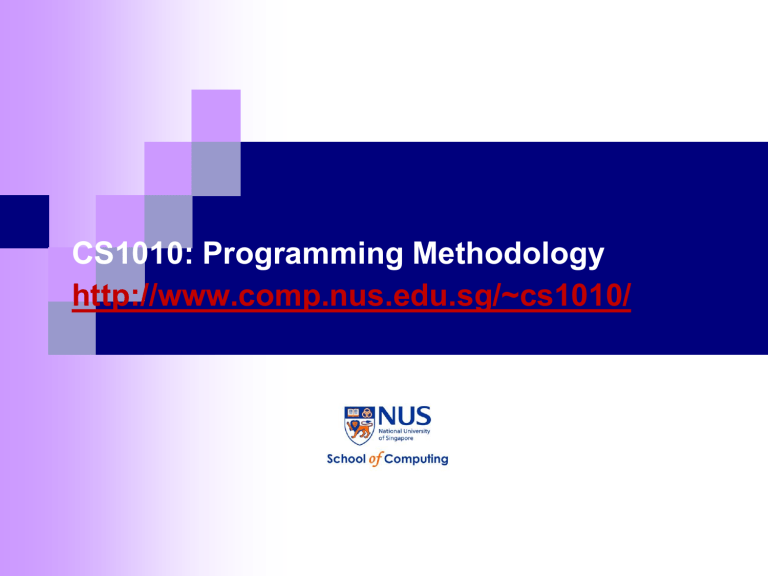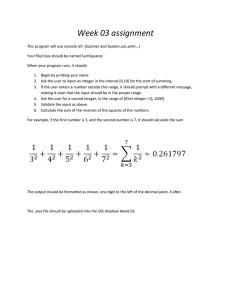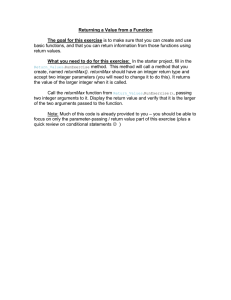Recess_extra_class.pptx

CS1010: Programming Methodology http://www.comp.nus.edu.sg/~cs1010/
Extra class: 25 September 2013
Objectives:
To go over the basic concepts covered in the first
6 weeks
To give out some programming exercises to test students’ understanding of these basic concepts
CS1010 (AY2013/4 Semester 1) Recess Extra Class - 2
Summary (1/2)
Week 1:
Writing algorithms (pseudo-codes)
Week 2:
Input (scanf) and output (printf)
Types (int, float, double, char, etc.) and variables
Mathematical operations (*, /, %, +, -)
About integer division
Week 3:
Top-down design
Writing functions
Using math functions
Discussion session: Writing algorithms, programming environment, using CodeCrunch
CS1010 (AY2013/4 Semester 1) Recess Extra Class - 3
Summary (2/2)
Week 4:
Selection statements: ‘if’, ‘if-else’, ‘switch’
Discussion session: Inaccuracy of real numbers, initialisation of variables, redundant assignment, writing functions.
Week 5:
Repetition statements: ‘while’, ‘do-while’, ‘for’
Discussion session: Good programming practice, using selection statements, conditional operator ?:, using repetition statements.
Week 6:
Functions with address parameters
Discussion session: Repetition statements, functions with address parameters, design issues, exploration on random numbers.
CS1010 (AY2013/4 Semester 1) Recess Extra Class - 4
Skills
Using vim
Pseudo-code before code
Clear logic
Can you convince yourself that your algorithm works before you start typing the program?
Simplifying the problem
If you get a complex problem, what would you do? (Reference:
Week 6 Discussion Q5 Asterisks)
Incremental coding
Do you type in the whole program at one go? Or a bit at a time?
Understanding compiler’s messages
Do you know where to zoom into your program to spot the error?
CS1010 (AY2013/4 Semester 1) Recess Extra Class - 5
Week 6 Discussion Q5: Asterisks
(b)
*
***
*****
*
***
*****
*******
*********
***********
(c)
*
***
*****
*
***
*****
*******
*********
***********
CS1010 (AY2013/4 Semester 1) Recess Extra Class - 6
Big Question
Have you been writing a lot of programs by yourself?
Target: Write 150 programs by the end of this semester
For students with no experience: 200 programs
Possible! Average about 17 programs per week over
12 weeks. Less than 3 programs a day!
CS1010 (AY2013/4 Semester 1) Recess Extra Class - 7
Tracing
Another important skill: Tracing codes .
Reinforce that program execution is done step by step following the sequence, selection and repetition control structures.
Every variable should be represented by a box, and its value updated during the trace.
Manually trace the given programs in the hand-out, and write out their outputs.
CS1010 (AY2013/4 Semester 1) Recess Extra Class - 8
Count multiples of 5 or 7 (Practice Ex #18)
Write a program multiples5or7.c
that asks user for a positive number num , and count the number of multiples of 5 or 7 in the range [1, num ].
Your program should have a function count_multiples(int)
Time limit: 10-15 minutes
Sample runs:
Enter positive integer: 10
There are 3 multiples of 5 or 7 in [1,10].
Enter positive integer: 6
There is 1 multiple of 5 or 7 in [1,6].
Enter positive integer: 50
There are 16 multiples of 5 or 7 in [1,50].
CS1010 (AY2013/4 Semester 1) Recess Extra Class - 9
Perfect numbers (Practice Ex #19) (1/2)
Definition:
A perfect number is a positive integer that is the sum of its proper positive divisors.
Examples:
6 is a perfect number, because 6 = 1 + 2 + 3
8 is not a perfect number, because 8
1 + 2 + 4
100 is not a perfect number, because 100
1 + 2 + 4 + 5 + 10 + 20
+ 25 + 50
Write a program check_perfect.c
that asks user repeatedly for a non-negative integer, and stops when the number is zero.
It should have a function is_perfect(int) that returns 1 if the parameter is a perfect number, or 0 otherwise.
For each positive integer entered, your program is to check whether it is a perfect number or not.
CS1010 (AY2013/4 Semester 1) Recess Extra Class - 10
Perfect numbers (Practice Ex #19) (2/2)
Time limit: 20-25 minutes
Sample run:
Enter number: 6
6 is a perfect number.
Enter number: 8
8 is a not perfect number.
Enter number: 100
100 is not a perfect number.
Enter number: 0
CS1010 (AY2013/4 Semester 1) Recess Extra Class - 11
Check order of input data (Pract. Ex #20) (1/2)
Write a program check_order.c
to read in a list of positive integers.
The program is to continue asking for the next positive integer as long as the integers entered so far are in increasing order.
The moment the input data are not in increasing order, or the input value is zero, the input ends.
The program should then report whether the input data are in increasing order or not.
You may assume that at least one positive integer is entered. If that is the case, we treat the list as in increasing order.
CS1010 (AY2013/4 Semester 1) Recess Extra Class - 12
Check order of input data (Pract. Ex #20) (2/2)
Time limit:
20-25 minutes
Sample runs:
Enter positive integer: 3
Enter positive integer: 0
Data are in increasing order.
Enter positive integer: 10
Enter positive integer: 12
Enter positive integer: 21
Enter positive integer: 0
Data are in increasing order.
Enter positive integer: 100
Enter positive integer: 102
Enter positive integer: 100
Data are not in increasing order .
Enter positive integer: 7
Enter positive integer: 31
Enter positive integer: 56
Enter positive integer: 56
Data are not in increasing order.
Recess Extra Class - 13 CS1010 (AY2013/4 Semester 1)
Reminders
Revise all of the following
Textbook and lecture notes
Discussion questions
Lab exercises
Write many programs!
Post queries on IVLE forum and read postings by others
You CAN succeed!
CS1010 (AY2013/4 Semester 1) Recess Extra Class - 14

